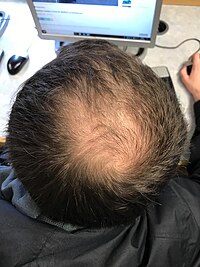
Photo from wikipedia
Keloid disorder is a tumour-like disease with invasive growth and a high recurrence rate. Genetic contribution is well expected due to the presence of autosomal dominant inheritance and various genetic… Click to show full abstract
Keloid disorder is a tumour-like disease with invasive growth and a high recurrence rate. Genetic contribution is well expected due to the presence of autosomal dominant inheritance and various genetic mutations in keloid lesions. However, GWAS failed to reveal functional variants in exon regions but single nucleotide polymorphisms in the non-coding regions, suggesting the necessity of innovative genetic investigation. This study employed combined GWAS, RNA-sequence and Hi-C analyses to dissect keloid disorder genetic mechanisms using paired keloid tissues and normal skins. Differentially expressed genes, miRNAs and lncRNAs mined by RNA-sequence were identified to construct a network. From which, 8 significant pathways involved in keloid disorder pathogenesis were enriched and 6 of them were verified. Furthermore, topologically associated domains at susceptible loci were located via the Hi-C database and ten differentially expressed RNAs were identified. Among them, the functions of six molecules for cell proliferation, cell cycle and apoptosis were particularly examined and confirmed by overexpressing and knocking-down assays. This study firstly revealed unknown key biomarkers and pathways in keloid lesions using RNA-sequence and previously reported mutation loci, indicating a feasible approach to reveal the genetic contribution to keloid disorder and possibly to other diseases that are failed by GWAS analysis alone.
Journal Title: PLoS Genetics
Year Published: 2022
Link to full text (if available)
Share on Social Media: Sign Up to like & get
recommendations!